Learning how to correctly use your car’s lights is essential for your own safety, the safety of your passengers and for the safety of other road users and pedestrians. The purpose of your car lights are:
- To be seen by others
- To see others and the road ahead
- To let other road users what you’re going to do
If you’ve only just recently passed your driving test, there’s every chance that you’ve never driven in the dark due to driving lessons typically taking place during the daytime. This car lights tutorial is for right-hand drive cars and will help to explain which lights to use on your car, how to switch them on, what the symbols mean and when to use them.
The Car Lights Switch
Depending on which car you have, the lights switch will be located in the following places:
- Dial switch on the dashboard, usually to the right-side of the steering wheel
- Twist switch, usually located on the left steering column stalk
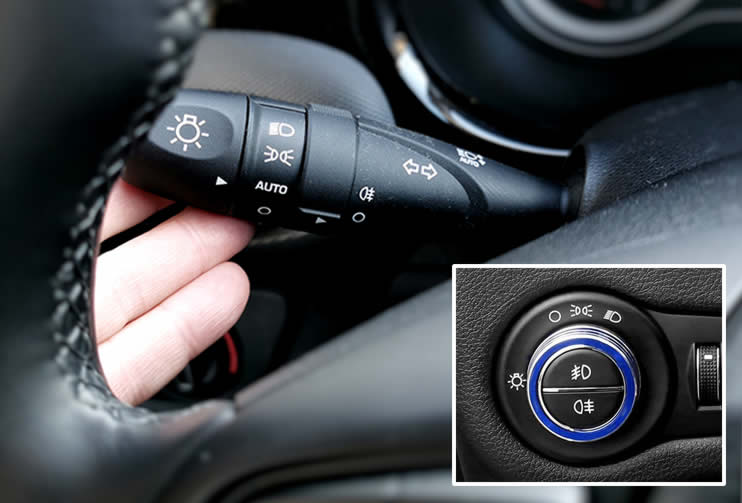
Though the location of a car’s light switch may vary, the lighting symbols are generally the same universally. If you’re not too sure where the light switch is, look for the symbols.
Car Lights and symbols Explained
A car’s external lights can operate slightly differently from car-to-car, but in general, they’re all quite similar. The same symbols on your lighting controls also light up on your car’s dashboard when activated. The illuminated dashboard symbols are the same colour as those below. Now we’ll explain the different types of lights on your car, what the car lights symbols mean and when they should be used.
![]() Lights Switch
Lights Switch
This symbol is to inform you of where your external light controls are. Look for this symbol on the dashboard or on one of the steering column stalks. On some models of car, switching to this symbol activates the sidelights.
 Sidelights
Sidelights
Switch your light control switch to this symbol and the sidelights are activated. When switched on, two white lights in each corner of the front of the car will illuminate along with two red tail lights and the number plate lights.
Sidelights also known as parking lights are low powered and are not as bright as your headlights. Because of this, when the engine is switched off, sidelights are designed to be left on for long periods of time without significant drainage of battery power.
The reason for this is because the Highway Code states that sidelights / parking lights must be on when parked on a road or lay-by that has a speed limit of over 30 mph. This is to ensure your car is visible to other road users.
Your sidelights / parking lights do not need to stay on if the road has a speed limit of 30 mph or less and as long as you’re parked in a dedicated parking bay or if not, then you’re car is parked in the direction of traffic flow.
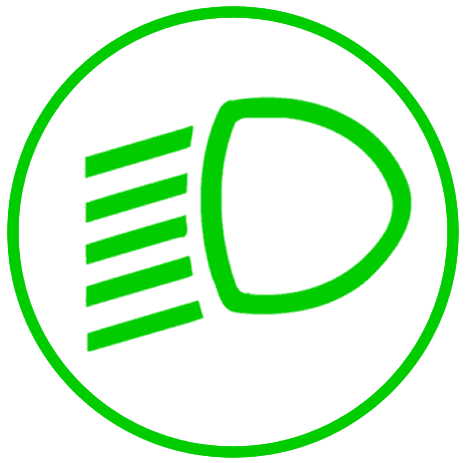 Low Beam Headlights
Low Beam Headlights
This symbol is what you need to switch to for activating your night driving headlights. Low beam, or dipped beam headlights as they’re also called are angled low towards the ground – hence the name.
These are the standard lights for driving at night. They’re brighter than your car’s sidelights, but not as bright as your full beam headlights. Low beam headlights are angled downs so that they do not glare oncoming drivers. When it starts getting dark or there’s heavy rain or snow, switch to this symbol to activate the low beam headlights.
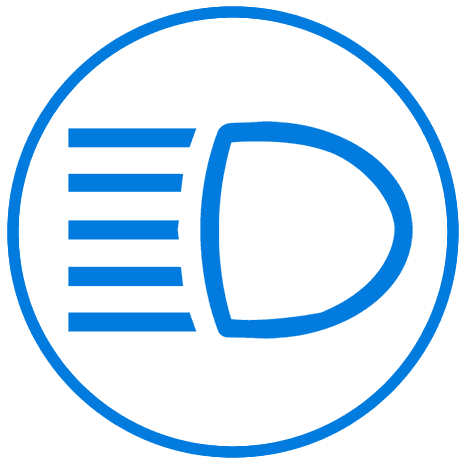 High Beam Headlights
High Beam Headlights
High beam or ‘full’ or ‘main’ beam headlights are the brightest lights on the car and unlike low beam headlights, they’re angled higher allowing the driver to see more of the road ahead.
The high beam headlights dashboard symbol is always illuminated in blue allowing for it to clearly standout from other symbols. To activate high beam headlights, first ensure the night driving low beam headlights are on, then push the left stalk on the steering column away from you. You’ll then see the blue symbol illuminate on the dashboard. Pull the stalk towards you to switch back to low beam headlights.
When to use High Beam Headlights
It’s important to only use high beam headlights on unlit roads and where there are no approaching vehicles, cyclists or pedestrians and when you’re not following another vehicle. Also switch to low beam headlights just before a left-turning bend.
The reason for this is because high beam headlights are extremely bright and will dazzle oncoming drivers to the point they’ll be unable to see anything. When following another vehicle, the dazzle of high beams can be overbearing in a driver’s mirrors.
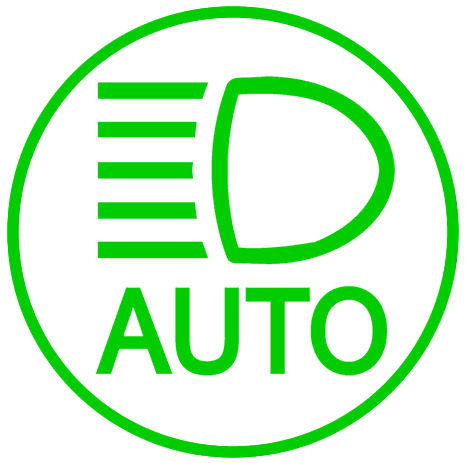 High Beam Assist
High Beam Assist
Some cars may have the option of using a high beam assist function. High beam assist is a system that automatically switches between high beam and low beam according to the brightness of other vehicles and road conditions. Note how the high beam assist symbol is similar to the high beams headlights symbol.
To activate high beam assist, you’ll first need to switch on automatic lights (see below). When automatic lights are activated, high beam assist will automatically switch between high and low beam once high beam has been selected by pushing the stalk away from you.
The method for activating high beam assist may vary a little depending on your car and the symbol may also vary slightly; this is another example of the high beams assist symbol: ![]() . Once high beam assist has been activated, the green symbol will illuminate on the dashboard and when high beams have been activated automatically by the system, the blue high beams symbol also illuminates.
. Once high beam assist has been activated, the green symbol will illuminate on the dashboard and when high beams have been activated automatically by the system, the blue high beams symbol also illuminates.
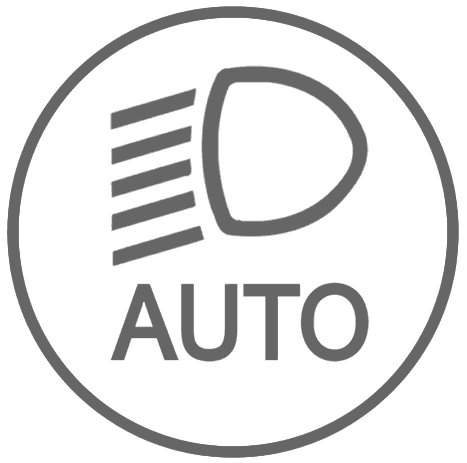 Automatic Lights
Automatic Lights
Many cars are now coming equipped with automatic lights. A sensor detects low light and automatically switches on your headlights. Automatic lights may also come equipped with high beam assist as detailed above. when automatic lights activate, your sidelights and low beam headlights are switched on.
If your car is equipped with automatic lights, you’ll have the option of switching on your lights manually, or using the automatic setting. Automatic lights symbols vary depending on your car. Here’s an example of what to look for on your external lighting controls: 1: ![]() 2:
2: ![]() 3:
3: ![]() . Automatic lights will also switch off with your car’s engine.
. Automatic lights will also switch off with your car’s engine.
When automatic lights switch on your headlights, the green sidelights symbol or green low beam symbol will illuminate on your dashboard, just as they would if you switched the lights on manually.
 Front Fog Lights
Front Fog Lights
Some cars have front fog lights, some do not as it’s not a legal requirement for car manufacturers to fit front fog lights. Look for this symbol on your car lights controls to see if you have front fog lights. You usually have to first switch on low beam headlights in order for front or rear fog lights to come on. When the front fog lights are on, this warning light will display in green on your car’s dashboard.
Fog lights are very bright and can dazzle other road users when used incorrectly. Ensure you only switch on your front fog lights when your visibility is 100 metres ahead or less.
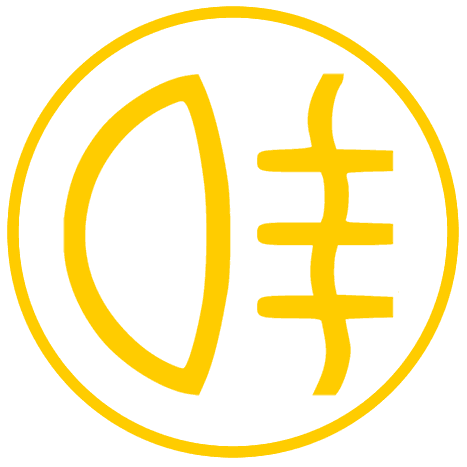 Rear Fog Lights
Rear Fog Lights
Unlike front fog lights, it’s a legal requirement for car manufacturers to install rear fog lights. The rear fog lights symbol is slightly different to the front fogs and once switched on, the symbol illuminates in amber on your car’s dashboard.
Rear fog lights illuminate in red and just as front fogs, they’re very bright and can dazzle driver’s behind you if used incorrectly. It’s important to remember to switch off all fog lights if visibility improves.
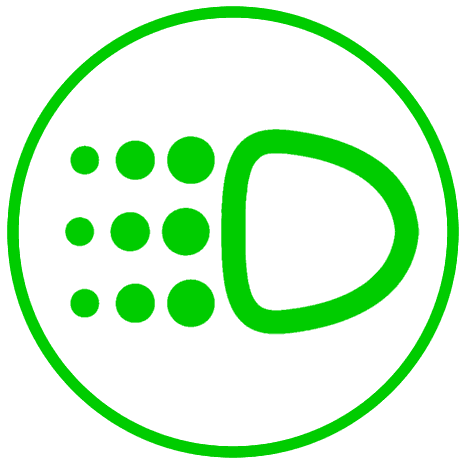 Daytime Running Lights
Daytime Running Lights
Daytime Running Lights, or DRL for short are specifically used to make it easier for others drivers to see you and not to help you, the driver to see where you’re going. While they improve safety during the day, they are especially beneficial after dawn and before sunset.
DRL’s have been mandatory on all newly manufactured cars in the EU since 2011 and switch on automatically when the engine is running. When the main headlights are switched on, the DRL’s either switch off or dim. While some cars have DRL’s fitted at both the front and rear, it’s only a requirement for cars to be fitted with DRL’s at the front.
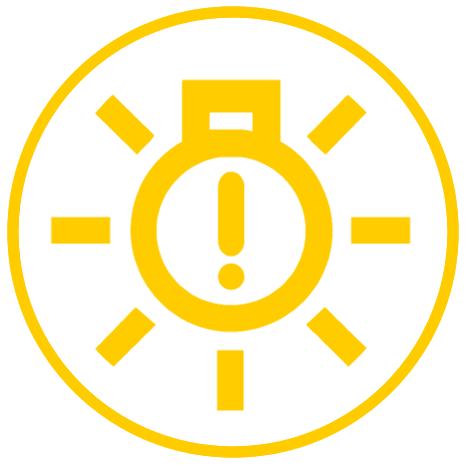 External Lights Fault
External Lights Fault
Any dashboard warning light that’s amber or red and has a exclamation mark is usually a fault of some sort. In this case, it’s an amber light bulb containing an exclamation mark.
This warning light illuminates to inform drivers that one of the car’s external lights has failed. Some cars may inform you of which light has failed. Equally, others cars may offer no warning of external light failure and so it’s the driver’s responsibility to make regular checks on your vehicle’s external lights to ensure they’re all working properly.
If a lights at the front or rear of your vehicle (don’t forget your brake lights) is defective, it’s important to get them fixed right away to avoid being stopped by the police. If stopped, you’ll likely receive a ‘vehicle defect rectification notice’ where’ll you’ll be given 14 days to have the fault rectified. Failure to do so may result in penalty points and a fine.